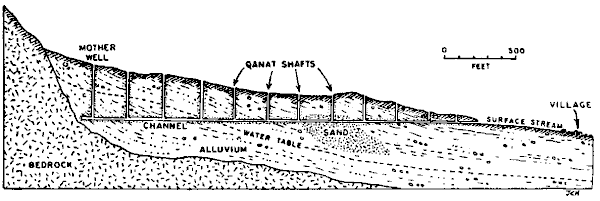 |
Science Frontiers ONLINE No. 129: MAY-JUN 2000 |
|
|
The Hidden 'Gardens'
 Cross section of a typical Iranian qanat. Unlike the exposed spring of the Bahrainian qanat, the water source here is at the bottom of a deep well. (From: Ancient Infrastructure) |
In our recent catalog, Ancient Infra-structure, we describe the qanats of Iran. (See figure.) Some of these shaft-tunnel structures run for miles and re-present a prodigious amount of labor. How prodigious? In Iran alone there are about 37,500 qanats with an aggregate length of some 100,000 miles! Qanats rank right up there with the Inca roads and the Great Wall of China as wonders of the ancient world.
After reading our catalog section on Iranian qanats, E. von Fange informs us that the qanats of Bahrain pose a set of different problems. The Bahrainian qanats are easy to follow across the desert because the access shafts protrude a few feet above the sand. As one follows them up-slope for a mile or two, some greenery appears in the distance---low bushes perhaps. A closer approach proves instead that the greenery is actually the tops of palms. These trees are growing in a sunken oval area about 200 yards long girt by a wall 20-30 feet high. Outside, the desert sand reaches nearly to the top of the wall; inside, steps lead down to limestone bedrock from which springs of crystal-clear water flow. The qanat entrance can be seen down near the bottom of the wall, but the water level is now too low to feed the abandoned qanat.
In his book Looking for Dilmun, G. Bibby asks some pertinent questions.
Has twenty feet of sand been dug away by hand over the enormous area needed to expose a matter of fifteen thousand square yards of bedrock and the springs that broke forth there? And was a twenty-foot wall then built and the sand piled back around it? And if so how had they known where to dig and find the springs? For if not there was only one other explanation. That we were standing there on the original ground surface. That once upon a time the whole hill slope had been naked rock at the level at which we stood, with springs in the hollows, and that the irrigation channels, probably indeed roofed from the start to prevent evaporation, had been dug at ground level or only a little below. In that case the sand came later, and the wall around the springs, together with the "chimneys" giving access to the qanats, had been built up gradually, to keep pace with the encroaching sand. This would suggest that the sand was comparatively recent, how recent only an investigation into the age of the qanats could determine.
(Bibby, Geoffrey; "The Hidden Gardens," Looking for Dilmun, New York, 1969, p. 45. Cr. E. von Fange.)
Comments. We wonder why sand has not blown over the wall into the "hidden garden." Ancient qanats are found in many arid areas around the Middle East and, very interestingly, in Peru's Nazca Valley, where they are called "puquios."
Scrabble players may be happy to learn that, as far as we can determine, "qanat" is the only word in our Webster's New World College Dictionary, where "q" is not followed by "u," except, of course for inadmissible proper names.
Other Sites of Interest
|